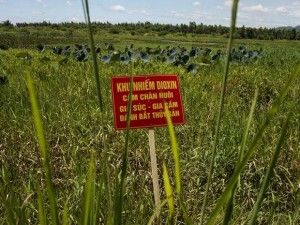
Publisher:
Bonnie King
CONTACT:
Newsroom@Salem-news.com
Advertising:
Adsales@Salem-news.com

~Truth~
~Justice~
~Peace~
TJP
Aug-13-2012 13:28

 TweetFollow @OregonNews
TweetFollow @OregonNews
The Terrible Legacy of Agent Orange
Will Robinson Special to Salem-News.comForty years after war ended, Washington begins decontamination of worst-affected areas in Vietnam
 Courtesy: ">Agent Orange Action Group |
(DA NANG, Viet Nam AOAG) - Tran Thi Hoan, 26, studied medicine only to be told that she couldn’t become a doctor because of a war fought 20 years before she was born. The ostensible reason was that she had no legs or left hand, but the main reason, and the cause of so much misery blighting the lives of millions of other Vietnamese, is the 20 million gallons of Agent Orange sprayed in her country by US forces in the Sixties.
She is one of three million Vietnamese affected by the dioxin in Agent Orange – a poison that has caused untold cancers and an estimated 150,000 birth defects – which continue down the generations to this day.
Last week, 40 years after the war ended, the US began a programme to try to decontaminate the worst-affected parts of the country, but even if the belated action grows into something far larger, it can never deal with the dreadful legacy of Agent Orange.
In a museum in the suburbs of Saigon, there is an exhibit where hundreds of photos of deformed adults, children and babies hang next to a copy of a letter which Tran Thi Hoan wrote to Barack Obama in 2009. After describing how doctors discouraged her from starting a family, fearing her children would be born with similar defects, she asked if the President would “spare a little time to resolve this forgotten problem”, after decades of quibbling over the issue in Washington.
Between 1962 and 1971, the US air force dropped around 20 million gallons of the herbicide during Operation Ranch Hand. Around 4,000 villages and communes in South Vietnam were sprayed, leaving at least 4.5 million Vietnamese exposed to the substance, according to census reports taken at the time. Five million acres of farmland were destroyed in the process (the size of Yorkshire, Lancashire and Northumberland combined), of which two million remain barren today.
Its claimed purpose was to defoliate the forest canopy that covered the Viet Cong’s troop movements and supply lines. Early on in the campaign, US planes dropped pamphlets written in Vietnamese assuring farmers that the chemicals were harmless to humans and animals. In spite of alleged warnings from chemical companies that the herbicide was potentially harmful, the US reportedly dropped the chemical at a higher concentration than what was recommended for destroying foliage.
As a result, the Vietnam Red Cross estimates that three million Vietnamese were left suffering from spina bifida, Parkinson’s and heart diseases as a result. Since then, at least 150,000 children have been born with birth defects, a number which the Vietnamese government claims could be as high as half a million.
Various court cases and pleas to the US government by Vietnamese victims have proved fruitless, whereas American veterans exposed to Agent Orange have had their appeals answered. Families of former US soldiers suffering because of dioxin poisoning get up to $1,500 (£956) a month in compensation, while Vietnamese families who have been affected receive around 80,000 dong a month (just over $5) in government support for their disabled children.
In 1984, chemical companies that manufactured the herbicide settled a class-action suit by US veterans for $180m. Then, in 2010, 200,000 veterans filed claims based on a policy change by the Department of Veterans Affairs which gave them easier access to compensation for health problems caused by exposure to the defoliant.
Vietnamese victims filed a similar lawsuit in 2004. The case brought by the Vietnam Association for Victims of Agent Orange against the chemical companies failed, with the court ruling that the herbicide was used to protect US troops against ambush and was not intended to be used against human populations. The manufacturers were also protected by a contract with the US government which employed them to manufacture and supply them with the herbicide during the war.
 |
For years, Washington has avoided discussing the Agent Orange-related health problems among the Vietnamese and the need for more scientific research into the problem. Since 2007 it has given about $60m for environmental restoration and social services in Vietnam, but last week’s project is its first direct involvement in decontaminating areas affected by dioxin.
The $43m project, which began last Thursday, is expected to be completed in four years. It covers a 47-acre site in the coastal city of Da Nang, one of many “hot spots” that have been identified on the perimeter of former US bases where Agent Orange was handled; 50 years on, dioxins still into the surrounding soil, posing a risk to the population.
Even though this is a step forward by the US in a relationship with Vietnam that has been hampered by the issue, the lasting legacy of Agent Orange will need a far more substantial input to repair the damage. In 2007, the non-partisan Aspen Institute determined that it would cost the US government $300m over 10 years to eliminate the remaining health threat and improve the lives of disabled people in Vietnam.
Special thanks to Chuck Palazzo, Salem-News.com
 |
 |
 |
 |
 |
 |
 |
Articles for August 12, 2012 | Articles for August 13, 2012 | Articles for August 14, 2012
Quick Links
DINING
Willamette UniversityGoudy Commons Cafe
Dine on the Queen
Willamette Queen Sternwheeler
MUST SEE SALEM
Oregon Capitol ToursCapitol History Gateway
Willamette River Ride
Willamette Queen Sternwheeler
Historic Home Tours:
Deepwood Museum
The Bush House
Gaiety Hollow Garden
AUCTIONS - APPRAISALS
Auction Masters & AppraisalsCONSTRUCTION SERVICES
Roofing and ContractingSheridan, Ore.
ONLINE SHOPPING
Special Occasion DressesAdvertise with Salem-News
Contact:AdSales@Salem-News.com

googlec507860f6901db00.html



Terms of Service | Privacy Policy
All comments and messages are approved by people and self promotional links or unacceptable comments are denied.
[Return to Top]
©2025 Salem-News.com. All opinions expressed in this article are those of the author and do not necessarily reflect those of Salem-News.com.